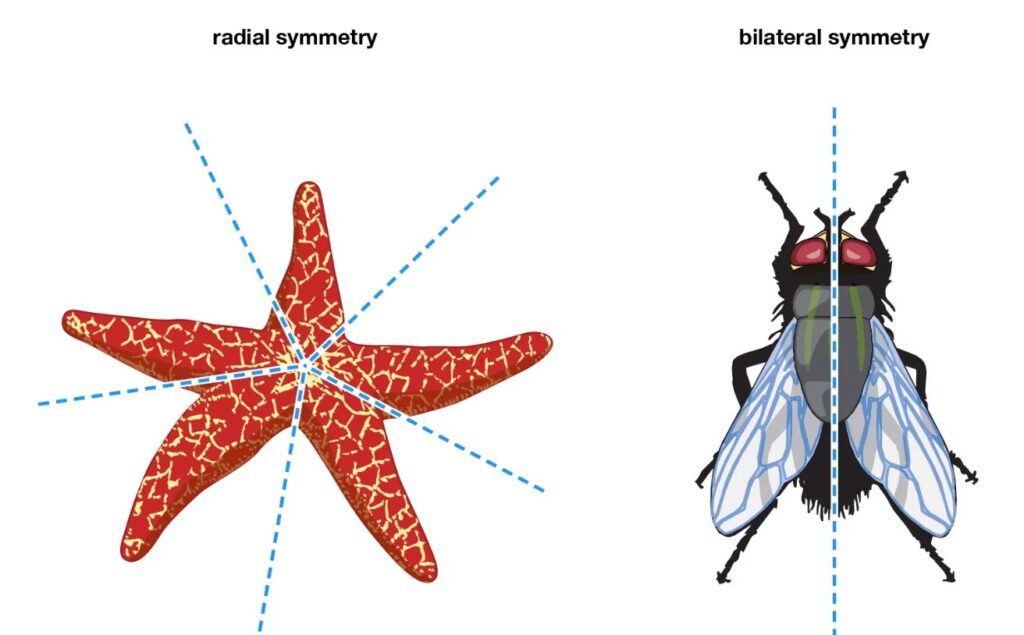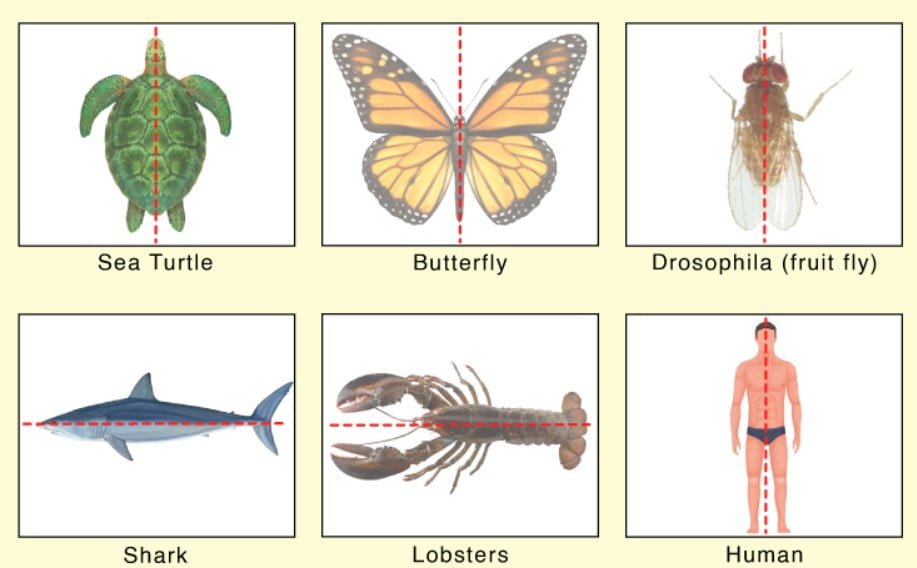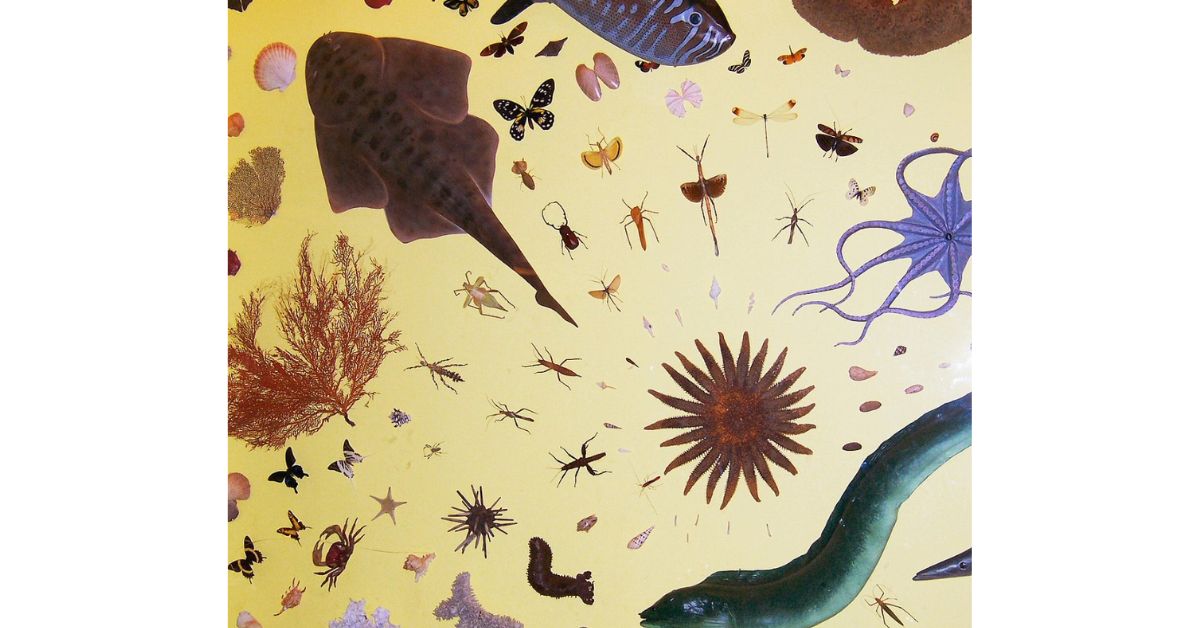Have you ever marveled at the perfect patterns in a starfish or the balanced proportions of a butterfly? Welcome to the fascinating world of symmetry in the animal kingdom! In this blog post, we’ll dive into the concept of radial and bilateral symmetry, uncovering the secrets behind these natural designs. Whether you’re a curious nature enthusiast or a budding biologist, prepare to be amazed by the symmetrical wonders of our planet’s creatures
Symmetry is like a special kind of balance or harmony where different parts of something look balanced and pleasing. In math, it means something stays the same after certain changes, like moving, flipping, turning, or resizing. The word comes from Greek and means things agreeing in size and shape.

Nature loves symmetry too! It’s all over the place and often shows that things are healthy and strong in living beings. Animals might pick mates with good symmetry because it could mean they have good genes. But symmetry isn’t just for looks. It can help animals move better and handle forces in their bodies. Even in the big picture of the universe, symmetry is super important. It helps explain why tiny particles act the way they do in physics.
Symmetry isn’t just about science though. It’s also about seeing the beauty in how things are put together. It’s a bit like a bridge between science and art, showing us how patterns and order are cool things to admire in both.
Radial Symmetry
Radial symmetry is a cool thing in nature! It refers to splitting an animal’s body into equal parts that all extend from the center, resembling slicing a pie into identical slices. Additionally, This type of symmetry is common in flowers and some sea creatures. Also, It helps them sense and interact with their surroundings from all sides. Here are some examples of animals with radial symmetry:
Jellyfish: They have a jelly-like body with tentacles.

Sea anemones: They look like flowers and stick to rocks or coral reefs.

Starfish: They have five arms coming from a middle disc.

Sea urchins: They’re round and covered in spines.

Radial symmetry helps these animals in a few ways. It makes it easier for them to grow back lost body parts, like a starfish regrowing an arm. It’s also handy for animals that stay in one place or move slowly because they can sense danger or find food from any direction. But it’s not all good news—this symmetry also means they’re not very fast and can’t see well in 3D, which can make escaping from predators or catching food harder.
Bilateral Symmetry

Bilateral symmetry is a fascinating thing in biology! It means that an organism can be split into two halves on either side of a particular line. This line divides the body into left and right sides that look like mirror images of each other. Lots of animals, including us humans, have bilateral symmetry. Think of fish, birds, insects, and even crustaceans they all have it! Having bilateral symmetry helps animals in a few important ways:
- It makes their movement smoother, especially in water or air.
- It gives them stability and balance, which are super important for getting around and staying coordinated.
- Animals with this symmetry often have a head with sensory organs at the front, helping them navigate and find food.
Overall, bilateral symmetry is a winning design in nature. Also, It helped tons of species survive and adapt to their surroundings, making it a crucial feature for thriving in the wild
From Sea to Land
Symmetry in biology refers to how an organism’s body parts are evenly spread around a central point or axis. There are two main types: radial and bilateral. Radial symmetry is like the spokes on a wheel, where parts go out from the center. It’s common in creatures like jellyfish and sea anemones that don’t move much. They can sense their surroundings from all directions, which helps them survive.
Bilateral symmetry occurs when an organism can be divided into two halves along a line. However, It’s more common and is present in animals with distinct front and back, top and bottom, and left and right sides. This type of symmetry enables smooth movement and assists animals in activities such as hunting and avoiding predators. Now, the environment has a big impact on how symmetry develops in organisms. For example, in animals, natural selection helps keep bilateral symmetry stable, and things like climate and terrain affect how plants grow symmetrically.
It’s thought that bilateral symmetry evolved from radial symmetry. Moreover, This change allowed for the development of a head and a more complex nervous system at the front of animals, which helped move around and sense the environment. Additionally, The evolution of symmetry happens over time through natural selection, where genes related to symmetry change in frequency.
Human Fascination with Symmetry
Human fascination with symmetry runs deep in our cultural and psychological fabric, resonating across various aspects of our lives. In art and architecture, people often associate symmetry with beauty, harmony, and balance. Furthermore, Architects use it to bring a sense of order and stability to buildings, whether they’re traditional or modern designs. Symmetry shows up in how they arrange building components, creating a central line with mirrored patterns on either side. From building placements to decorative elements like roofing and borders, symmetry influences architectural aesthetics.
In art, symmetry inspires, as masterpieces like Leonardo da Vinci’s ‘Last Supper’ demonstrate, where balance and symmetry are evident in composition and color use. Symmetry also shines in patterns, mandalas, and backgrounds, creating visual equilibrium and emphasizing specific objects or themes.

Observing symmetry has profound psychological effects, engaging in ongoing visual processes that interact with other cognitive functions. Symmetry aids in perception, helping distinguish living organisms from inanimate objects and serving as a cue for mate selection. Moreover, It evokes feelings of uniformity, clarity, and consistency, crucial in eliciting specific sensations in art.
The human visual system excels at discerning bilateral symmetry, deeply intertwined with cognitive processes and shaping our perception of the world. Also, Symmetry, defined as object invariance under transformations, is fundamental in perceiving objects in three dimensions, enriching our understanding of spatial relationships.
Facts To Know
Animals with Radial Symmetry:
- Examples include jellyfish, sea anemones, sea stars (starfish), and sea urchins.
- Radially symmetrical animals typically have body parts arranged around a central axis, resembling spokes on a wheel.
- Marine habitats, both in shallow and deep waters, are common locations for the presence of these creatures.
- Radial symmetry allows these animals to interact with their environment equally from all directions.
- They exhibit a simple nervous system and lack a distinct front or back.
- Many radially symmetrical animals can regenerate lost body parts, such as the regrowth of arms in starfish.
Animals with Bilateral Symmetry:
- Examples include humans, vertebrates (such as fish, amphibians, reptiles, birds, and mammals), insects, spiders, and crustaceans.
- Bilaterally symmetrical animals can be divided into two halves by a plane of symmetry.
- They typically have distinct front and back, top and bottom, and left and right sides.
- Bilateral symmetry facilitates streamlined and directional motion, enabling complex behaviors like predator-prey interactions.
- These animals often have a centralized nervous system, with sensory organs concentrated at the anterior end, aiding in navigation and detecting food.
- Bilateral symmetry is prevalent in both aquatic and terrestrial habitats and is widespread among animals, including humans, making it one of the most common types of symmetry in the animal kingdom.
Read Also
Interesting Facts About Cats That Will Amaze You
Fun Facts About Cats | A Playful Journey Into Feline Curiosity
Conservation of Symmetrical Species
Challenges Facing Symmetrical Species:
- Habitat Destruction: Natural habitats are being cleared for activities such as deforestation, mining, and urban development.
- Climate Change: Shifts in climate disrupt ecosystems and the survival of species.
- Invasive Species: Non-native species can outcompete native ones and disturb the ecological balance.
- Overexploitation: Species are being harvested or consumed at unsustainable rates, leading to population declines.
- Pollution: Harmful chemicals introduced into ecosystems affect various organisms.
Conservation Efforts and Ways to Help:
- Protected Areas: Establishing and managing protected areas to safeguard habitats.
- Species Management: Implementing sustainable practices to manage ecosystems and control invasive species.
- Habitat Restoration: Participating in efforts to reduce habitat loss and restore degraded habitats.
- Supporting Organizations: Contributing to wildlife conservation organizations like WWF.
- Personal Actions: Reducing your carbon footprint, choosing sustainable products, and raising awareness about conservation.
Conclusion
Lastly, Symmetry is more than just a visual treat; it’s a testament to the efficiency and adaptability of life on Earth. As we’ve explored the realms of radial and bilateral symmetry, we’ve seen how these patterns are not just aesthetically pleasing but also crucial for survival. So next time you spot a symmetrical pattern in an animal, take a moment to appreciate the intricate dance of nature and evolution.
Not all animals have radial or bilateral symmetry. Some animals exhibit asymmetry or other forms of symmetry, like spiral symmetry in certain mollusks, while others lack clear symmetry altogether, such as sponges. The presence of radial or bilateral symmetry varies among different animal groups.
Dogs exhibit bilateral symmetry, meaning their left and right sides mirror each other if you draw a line down their center. This type of symmetry is common in animals with distinct heads and tails, front and back, and left and right sides, such as humans, dogs, cats, and elephants. Unlike radial symmetry, found in marine organisms like jellyfish, dogs, being terrestrial animals, are bilaterally symmetrical.
A butterfly displays bilateral symmetry, where its left and right sides are mirror images of each other if you were to draw a line down the center of its body. This type of symmetry is typical for organisms that can be divided into two nearly identical halves along a single plane, as seen in butterflies. It’s a common trait among animals that have distinct head and tail, front and back, and left and right sides.










